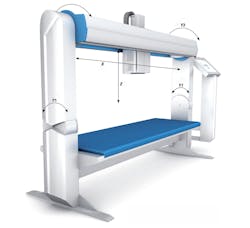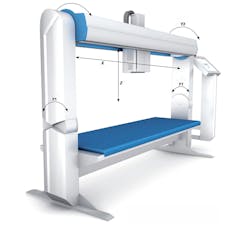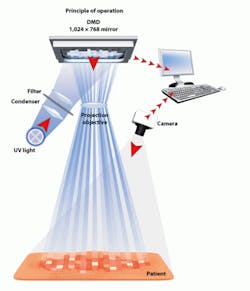Precise stepper motors keep UV light on target
High-precision sine-commutated stepper-motors let a medical phototherapy device beam UV light only at areas of a patient’s skin that need it.
The Skintrek PT5 UV exposure device has four axes of motion and responds to even small movements by the patient. Developed by Lüllau Engineering GmbH in Germany, it transmits intense UV beams so they miss healthy skin and irradiate only afflicted areas. A total of seven sine-commutated stepper motors of differing sizes precisely position the beams. Developed by Nanotec Electronic U. S. Inc., Medford, Mass., the motors are part of the Plug & Drive Series, which combines the controller and encoder in a single housing. The integrated approach considerably reduces cabling requirements.
A PD4-N6018 Model stepper with a 3.54-Nm holding torque sits in the crossbeam (Y2 axis) where the exposure head resides. The motor can rotate the crossbeam by 20° on either side. This swiveling lets beams precisely cover the side areas of the body.
Two PD4-N5918 drives control the adjustment of the entire exposure unit (Y1 axis) around a pivot point so the exposure head can cover the sides of patients. The two motors are synchronous but run autonomously, thanks to their built-in controllers.
The exposure head mounts in the cross member. The UV light source, a color filter disk, light modulator, and camera also reside there. The continuous radiation from a UV light source first goes through a collimator and is filtered so either a 320-to-400-nm or 300-to-320-nm spectrum reaches the digital light modulator. The machine uses image-recognition data and a dosage calculation to only switch on pixel beams that hit afflicted areas of the skin (lesions).
The light modulator is a micromechanical semiconductor component (DLP technology from Texas Instruments, Dallas) consisting of a 768 × 1,024 array of mirrors each only about 11 × 11 µm that can be mechanically tilted ±12°. A color filter wheel between the light source and the light modulator produces the color spectrum needed for the particular skin disease being treated. Positioning is via NEMA-8 stepping motors controlled from an external controller developed in-house.
The entire exposure unit can move independently in the crossbeam, both back and forth (X axis) and vertically (Z axis). In the interest of a uniform drive architecture, a PD4-N5918 motor handles the X and Z axes, both of which have a holding torque requirement of 0.4 Nm.
Two Nanotec ST4118 stepper motors and the external SMCI47 controller set the height with a linear slide using field-oriented control with sinusoidal commutation. This lets the motors run with true torque control, high precision, and low resonance.
A special camera in the exposure head detects afflicted skin. A computer examines images to ensure the device only irradiates the exact contours of lesions. The camera also notes when patients move slightly and the computer adjusts the UV radiation to compensate within fractions of a second.
Skin areas oblique to the irradiation direction also get the right dosage. In addition, the physician can set dosage profiles so UV light intensity fades at the lesion edges.


